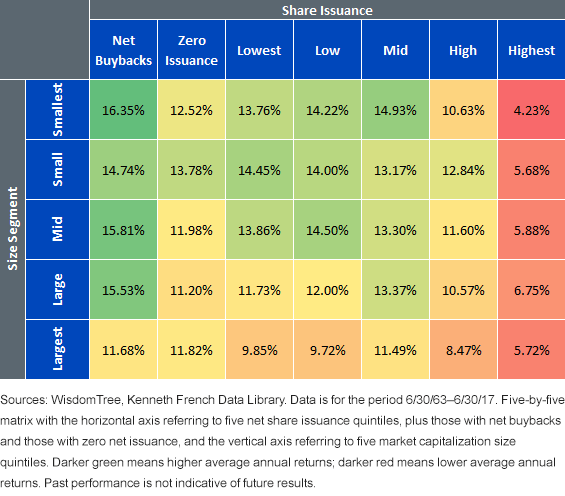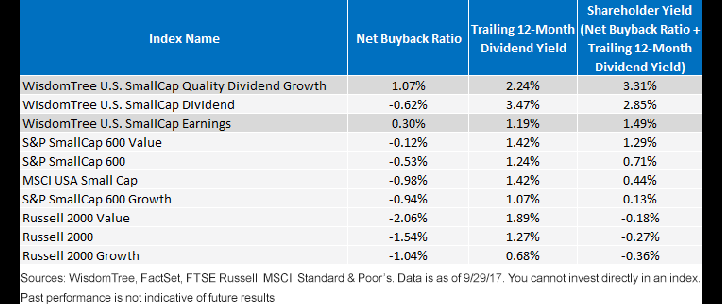Unexpected Sources of Share Buybacks


A few years ago, WisdomTree coined the phrase “Forgotten Dividend Payers” to refer to mid-cap and small-cap companies that pay dividends. In a yield-starved environment, within the United States one could dip down the market capitalization-size spectrum to find higher dividend yields.
The Share Buyback Phenomenon
Share buybacks have generated a lot of attention within the low-yield environment that we’ve seen since the global financial crisis of 2008–2009. For example, in 2017, we saw Apple commit to a program to return $300 billion to shareholders by March 2019. $210 billion of this would be in the form of a share buyback.1 The reality for U.S. large-cap firms—especially U.S. large-cap technology firms—is that they choose to utilize share buybacks as an important means of returning cash to shareholders.
But what about small caps?
Long-Term Record Indicates Small Caps with Net Buybacks Have Been Strong
(6/30/1963–6/30/2017)

- Looking at the boxes, one can’t help but notice that most of the darkest green boxes (highest average annual returns) occurred in the “Net Buybacks” column. This means that firms that were buying back shares tended to outperform firms that were issuing shares. Additionally, the firms on the smaller end of the market capitalization spectrum (higher rows vertically) also tended to do better than the firms on the larger end of the spectrum (lower rows vertically).
- One question that people may ask is, how many firms are represented within the smallest quintile that are engaging in share buybacks? Clearly, it wouldn’t be a static number, but to give people a sense, the lowest number of firms in this category was 61 in May and June 1970. For context, in June 2017, there were 290 firms in this category. So we would feel comfortable that the 16.35% per year would represent a diversified array of U.S. small-cap companies.2
In the Shift to Passive Investing, How Do U.S. Small-Cap Indexes Do on Share Buybacks?
Recently, investors have been largely shifting their assets from actively managed strategies to passively managed strategies, many of which are in exchange-traded funds (ETFs). This means that small-cap strategies tend to be accessed via different variants of the Russell 2000 Index, the S&P SmallCap 600 Index, and the MSCI USA Small Cap Index.
In a way, these “beta” indexes represent the U.S. small-cap equity market. True, some are more selective than others, but their characteristics indicate more what U.S. small caps as a whole are doing rather than any stock selection or weighting strategy.
Decomposition of Shareholder Yield across U.S. Small-Cap Indexes (as of 9/29/17)

For definitions of indexes in the chart, visit our glossary.
- The WisdomTree U.S. SmallCap Quality Dividend Growth Index and the WisdomTree U.S. SmallCap Earnings Index stand out as the only U.S. small-cap indexes shown (out of a relatively broad set) that had positive net buyback ratios. We will discuss why these two Indexes are uniquely positioned to do this with some consistency as opposed to this being a one-time, unique occurrence in this period.
- It’s also notable to compare the S&P SmallCap 600 Index, the MSCI USA Small Cap Index and the Russell 2000 Index in terms of their net buyback ratios. They are all negative (meaning that in aggregate these firms are issuing shares), but the Russell 2000 Index was approximately three times as negative (meaning approximately three times as much share issuance) as the S&P SmallCap 600 Index.
WisdomTree’s Approach to Small-Cap Quality
So, the long-term data would suggest that small-cap stocks that are buying back their shares have tended to generate stronger long-term returns than small caps that are issuing more shares. We mentioned earlier that both the WisdomTree U.S. SmallCap Quality Dividend Growth Index and the WisdomTree U.S. SmallCap Earnings Index are positioned to screen out low-quality firms that may be at greater risk of issuing shares to raise new capital.
- WisdomTree U.S. SmallCap Earnings Index: Each year, this Index eliminates firms with negative core earnings and re-tilts weight toward firms with the greatest core earnings. The result is that the firms at greatest risk of using share issuance to raise capital may not even be in the Index in the first place.
- WisdomTree U.S. SmallCap Quality Dividend Growth Index: Each year, this Index undertakes a growth and quality screen, thereby zeroing in on firms with stronger relative earnings growth and higher return on equity and return on assets (therefore, low leverage).
Conclusion: Small-Cap Quality Dividend Growth Is Best Positioned to Have Higher Net Buybacks
If you were to ask which single WisdomTree U.S. small-cap Index is best positioned to capture any long-term premium associated with small-cap firms that buy back their shares, our answer would be the WisdomTree U.S. SmallCap Quality Dividend Growth Index. The fact is that the quality and growth screens have a unique side effect of screening out those firms at the greatest risk of issuing shares to raise capital. It may not mean outperformance over every year, but we think the long term could be quite exciting.
1Source: “Apple Reports Second Quarter Results,” Apple Newsroom press release, 5/2/17.
2Source: “25 Portfolios Formed on Size and Net Share Issuance,” Kenneth French Data Library, updated as of 6/30/17.
Important Risks Related to this Article
Investments focusing on certain sectors and/or smaller companies increase their vulnerability to any single economic or regulatory development.

Christopher Gannatti began at WisdomTree as a Research Analyst in December 2010, working directly with Jeremy Schwartz, CFA®, Director of Research. In January of 2014, he was promoted to Associate Director of Research where he was responsible to lead different groups of analysts and strategists within the broader Research team at WisdomTree. In February of 2018, Christopher was promoted to Head of Research, Europe, where he was based out of WisdomTree’s London office and was responsible for the full WisdomTree research effort within the European market, as well as supporting the UCITs platform globally. In November 2021, Christopher was promoted to Global Head of Research, now responsible for numerous communications on investment strategy globally, particularly in the thematic equity space. Christopher came to WisdomTree from Lord Abbett, where he worked for four and a half years as a Regional Consultant. He received his MBA in Quantitative Finance, Accounting, and Economics from NYU’s Stern School of Business in 2010, and he received his bachelor’s degree from Colgate University in Economics in 2006. Christopher is a holder of the Chartered Financial Analyst Designation.

